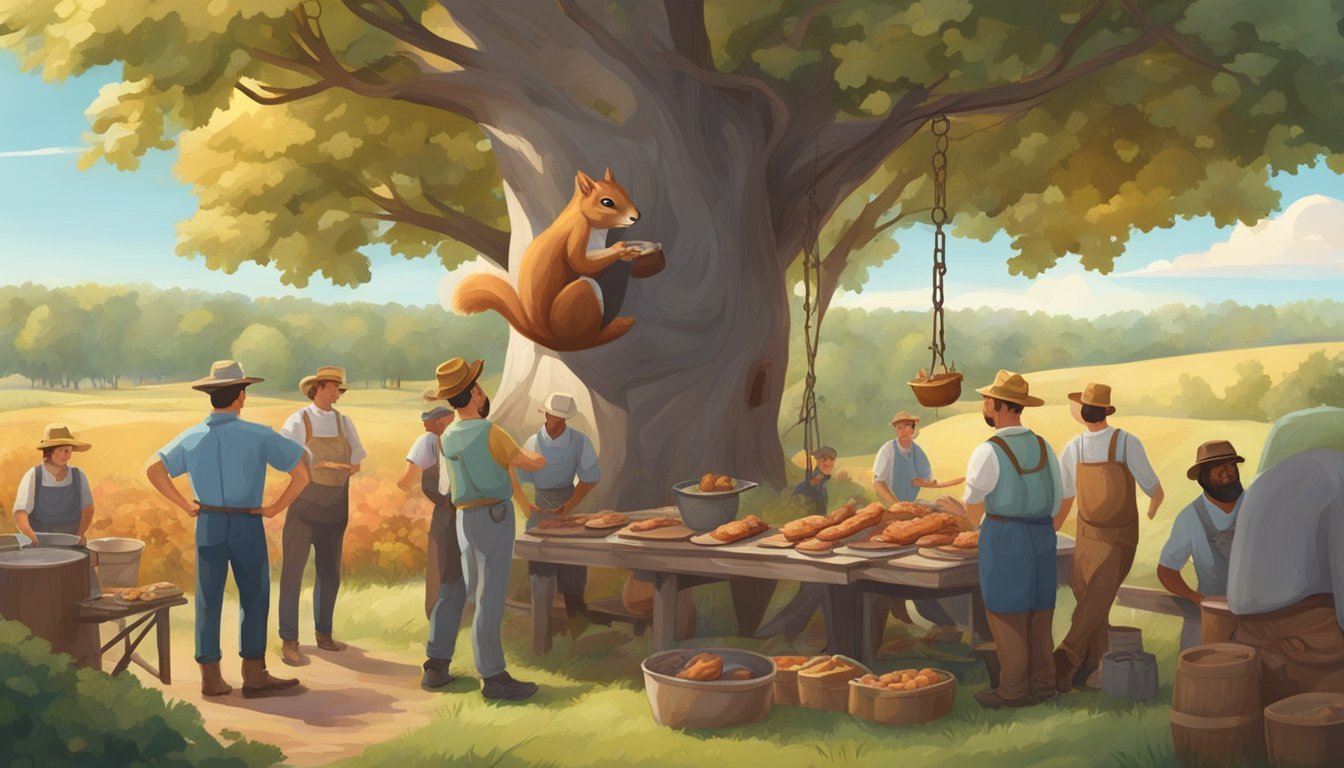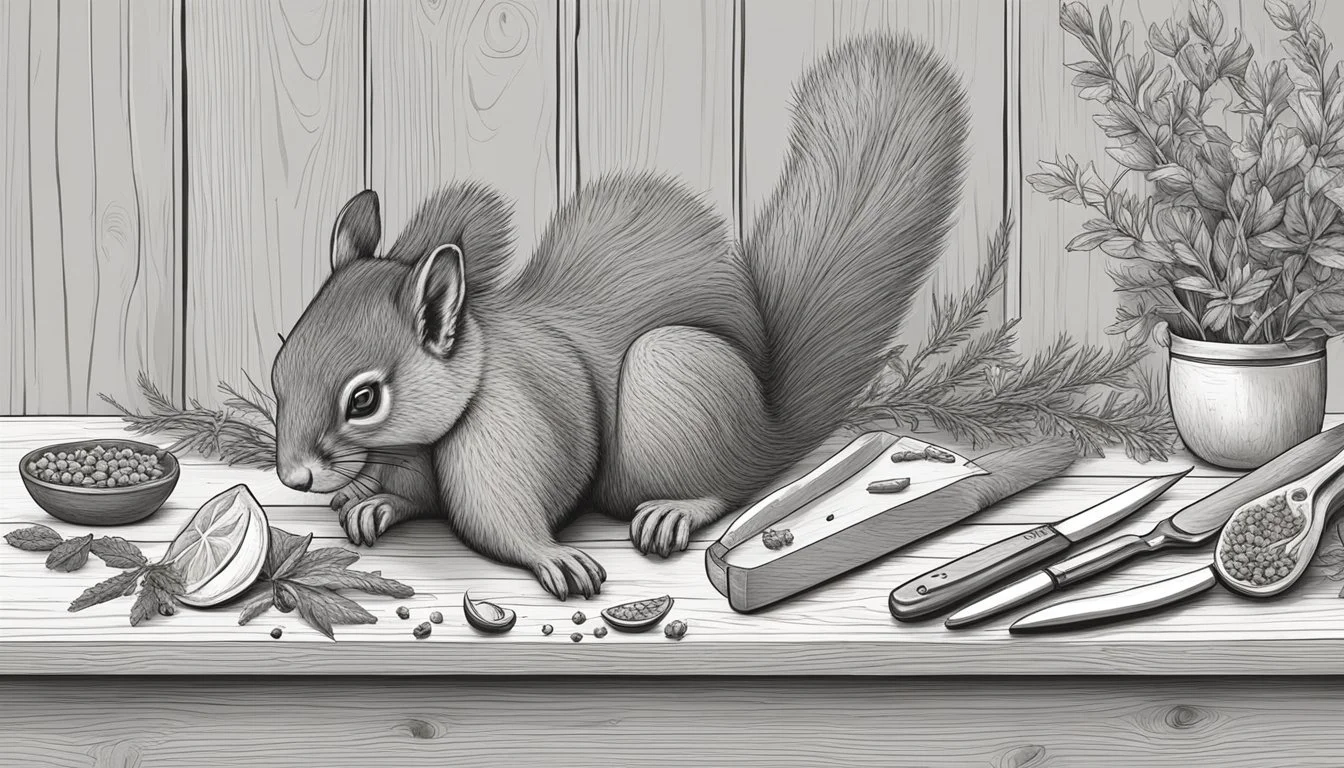Squirrel Meat
A Hidden Gem in Rural American Cuisine
Squirrel meat is a culinary tradition steeped in the rural American heritage, offering a surprisingly rich and diverse gastronomic experience. Historically regarded as a staple in the diets of Native Americans and early settlers, squirrel has been a source of sustenance in North America for centuries. Its consumption, while less common in urban areas, persists in many rural communities where hunting and self-reliance remain integral to daily life. Today, this meat is appreciated for its lean texture, versatility in preparation, and deep, nuanced flavors that can enhance a variety of dishes.
As a game meat, squirrel presents an array of cooking possibilities, ranging from slow-cooked stews (What wine goes well with stews?) to barbequed preparations. The meat is known for its tenderness when cooked properly, making it well-suited for slow-cooking methods which infuse it with the flavors of accompanying vegetables and spices. Nutritionally, it offers a high-protein, low-fat option for those seeking alternative sources of meat. Its subtle gaminess and texture have led to its incorporation into both traditional recipes and modern culinary innovations alike, reflecting the adaptability of rural American cooking.
The practice of cooking squirrel meat aligns with a growing interest in sustainable and local food sources. This small game animal reproduces quickly and can be hunted without significantly impacting the ecosystem, making it an environmentally conscious choice for meat consumption. While it may not occupy the mainstream tables of America, squirrel meat endures as a testament to the country’s rich food heritage and the ingenuity of its people in utilizing the natural resources available to them.
History and Cultural Significance
Squirrel meat holds a significant place in the tapestry of rural American cooking. Historically, it was a common source of protein for settlers who hunted the animal for sustenance. In North America, the pursuit of squirrel meat wasn't just a means of nutrition; it also ingrained itself as a cultural practice, particularly in Appalachian regions.
Settlers across North America widely engaged in squirrel hunting, with the practice being passed down through generations. It was especially prevalent during times when livestock was not yet established or in areas where other meats were scarce. Squirrel meat found its way into early versions of American cookery books, reflecting its commonplace in the diet of early Americans.
Recipes featuring squirrel were often simple, exemplifying the resourcefulness of rural American cooks. Squirrel stew, with its hearty vegetables and foraged herbs, became a staple dish. The meat’s versatility allowed it to be used in various culinary applications, from roasts to pies.
James Beard, a prominent advocate for American cuisine, acknowledged the role of such game meats in the country’s culinary heritage, although squirrel recipes became less common in cookbooks as commercial meats grew more accessible.
Today, while not as widely consumed, squirrel meat remains a niche component of America's rich culinary history, holding particular reverence among regions that continue to practice traditional hunting and cooking methods.
Nutritional Profile of Squirrel Meat
In considering the nutritional aspects of squirrel meat, it is essential to examine its macro and micronutrient contents, especially focusing on elements such as protein, iron, total fat, cholesterol, and potassium.
Comparative Analysis with Other Meats
When comparing squirrel meat to other types of meat, it's important to examine specific nutritional components:
Protein:
Squirrel meat is an excellent source of protein, with about 75% of its calories coming from protein, which is a higher proportion compared to many other meats.
Iron:
The iron content in squirrel meat complements a healthy diet, as iron is crucial for oxygen transport in the blood and for various metabolic processes.
Total Fat:
At 25% of its calories from fat, squirrel meat has a moderate total fat content. However, the type of fat can vary based on the squirrel's diet and the preparation method used for cooking.
Cholesterol:
Squirrel meat does contain cholesterol; however, the exact amount may vary. Cholesterol levels in meat are not always a direct indicator of health impact and should be considered within the context of a balanced diet.
Potassium:
Like many meats, squirrel meat also contains potassium, which is vital for maintaining normal body functions, including nerve signaling and muscle contractions.
Health and Nutrition:
From a health and nutrition perspective, squirrel meat can be a sensible part of a balanced diet, especially due to its high protein content and the presence of vital nutrients such as iron and potassium. The key is to prepare it in a way that maintains its nutritional benefits, such as slow cooking or stewing, to preserve these nutrients.
Hunting and Conservation
Squirrel meat is a traditional food source in rural America, and its procurement is closely linked to conservation efforts and regulated hunting practices. Understanding the habitat preferences of different squirrel species, adhering to ethical hunting procedures, and operating within established hunting seasons and regulations are vital for maintaining balance within ecosystems.
Types of Squirrels and Habitats
In the United States, the most commonly hunted squirrels are the gray squirrel (Sciurus carolinensis), red squirrel (Tamiasciurus hudsonicus), and fox squirrel (Sciurus niger). Gray squirrels prefer deciduous forests rich in nut-producing trees, red squirrels are found in both coniferous and mixed forests, and fox squirrels favor the more open habitats of hardwood and pine forests.
Gray Squirrel: Mixed hardwood forests
Red Squirrel: Coniferous and mixed forests
Fox Squirrel: Hardwood and pine forests
Ethical Hunting Practices
Ethical hunting practices ensure that hunters take responsibility for the welfare of the wildlife they hunt and the sustainability of the population. Hunters should:
Aim for a clean shot to ensure a humane harvest
Follow the principle of fair chase and avoid over-harvesting
Use only the necessary equipment and caliber for hunting squirrels
Squirrel Hunting Season and Regulation
The squirrel hunting season and regulations can vary by state but are typically confined to specific months of the year to protect populations during breeding and to allow young squirrels to mature. Hunting season usually falls between late fall and early winter. Regulations include:
Hunting Season: Determined by the state wildlife agency
Daily Bag Limit: Varies by state, often around 3-10 squirrels
License Requirements: Hunters typically need a valid hunting license
Regulations also help maintain the sustainability of wild game and ensure that squirrel hunting continues to be a viable part of American outdoor traditions.
Preparing Squirrel Meat
When preparing squirrel meat, a meticulous approach to cleaning and safety is essential. Tenderizing and marinating can enhance the flavor, while various cooking methods, like braising, baking, and slow cooking, can be employed to create a palatable dish.
Cleaning and Safety
Before cooking, the squirrel meat must be processed safely. Hunters typically:
Skin and gut the animal promptly after the hunt to prevent bacteria from growing.
Rinse the meat under cold water to remove any residual fur, dirt, or debris.
Inspect the meat for signs of disease. Discoloration or an off odor may indicate the meat is not safe to eat.
Preparing the meat in a clean environment with sanitized tools is crucial to avoid contamination and ensure the meat is safe for consumption.
Tenderizing and Marinating
Due to the lean nature of squirrel meat, it benefits from tenderizing methods. Aging the meat or using a marinade can make it more tender and flavorful. They can:
Age the meat in a refrigerator for a couple of days.
Apply a marinade with acidic components like vinegar or citrus juice. This step also infuses the meat with flavors.
Marinating should be done in a cold environment like a fridge for several hours or overnight, securely covered to avoid cross-contamination.
Cooking Methods
After the meat has been prepped, various cooking techniques can be utilized based on the desired outcome:
Braising: Involves cooking the meat slowly in a small amount of liquid within a covered pot or Dutch oven.
Baking: A dry-heat method that works well after an initial sear of the meat.
Slow Cooking: The meat can be placed in a slow cooker to gradually break down the fibers, yielding a tender, succulent stew.
One can opt to brown the meat first in a skillet before transferring it to a stew or bake to seal in the flavors. Each method has its particular benefits and can create a dish that showcases this unique delicacy.
Recipes and Culinary Techniques
In this section, we'll explore the diverse methods used to transform squirrel meat into delicious and hearty meals. These recipes highlight the unique flavors and textures of this rural American delicacy.
Squirrel Stew and Soups
Squirrel stew is a classic recipe that brings out the meat's rich flavor and tenderizes its naturally lean texture. To prepare squirrel stew, chefs typically brown the meat, then simmer it with vegetables such as carrots, celery, and onions in a flavorful stock. Common seasonings include garlic, pepper, and rosemary. This slow cooking process, which can be done in a slow cooker or on the stovetop, leads to a hearty meal often enhanced by adding beans, corn, and diced tomatoes.
Brunswick Stew: This traditional dish combines squirrel meat with corn, tomatoes, and lima beans, creating a thick and savory stew.
Squirrel and Dumplings: Similar to chicken and dumplings, featuring dough pieces cooked directly in the stew for a comforting finish.
Roasted and Baked Squirrel
Roasting or baking squirrel accentuates the dark meat’s hearty qualities. After browning in flour, squirrel pieces are placed in a baking dish and cooked in an oven. This method yields a crisp exterior and juicy interior. Pot pie is another favored baked dish, involving a buttery pastry crust filled with tender squirrel meat, vegetables, and a rich creamy sauce often made with milk or buttermilk.
Squirrel Casserole: This dish involves layering squirrel meat with cream of mushroom soup, vegetables, and seasonings in a casserole dish, then baking until bubbling.
Baked Squirrel with Vegetables: Simple yet flavorful, mix the meat with a medley of vegetables and roast until everything is tender.
Alternative Dishes and Substitutes
Squirrel meat can be substituted in many recipes that traditionally call for chicken or rabbit. Its versatility allows it to be used in various dishes that require a flavorful protein.
Squirrel Rollups: Like chicken rollups, these involve squirrel meat wrapped in dough with onions, peppers, cheese, and herbs, baked until golden.
Spicy Squirrel Legs: Replace chicken wings with squirrel legs, season with a spicy coating, and bake or fry for a unique appetizer.
Using squirrel meat offers a sustainable and traditional alternative to common proteins. These recipes allow home cooks to explore a range of flavors and techniques typical of rural American cooking.
Serving and Presentation
In preparing squirrel meat, achieving a balance between the richness of the meat and the choice of sides and garnishes is crucial. This ensures that every dish not only looks appetizing but also complements the flavors of the game meat.
Accompaniments and Sides
The hearty flavor of squirrel meat pairs well with a variety of sides. A traditional approach includes vegetables like carrots, lima beans, and okra which add a sweet and earthy balance to the dish. When planning accompaniments, one might consider:
Roasted or mashed potatoes: For a creamy texture that contrasts with the meat's tenderness.
Cooked rice or creamy grits: To soak up any gravy or juices, providing a complete taste experience.
Garden salads: Offering a crisp, fresh counterpoint to the richness of the meat.
Adding traditional spices such as thyme to these sides can bring out the flavors of the squirrel meat.
Plating and Garnishes
Presentation of the squirrel meat should be enticing. Care should be taken to plate the meat when it’s golden brown, which signifies a perfect outer texture while maintaining juiciness inside. Consider the following for an effective presentation:
Garnishes: Sprinkle with kosher salt and fresh herbs right before serving. A wedge of lemon on the side allows guests to add a citrus zing to their preference.
Sauce drizzle: A modest drizzle of Worcestershire sauce or hot sauce can enhance the meats’ flavor and add an attractive glaze to its surface.
To add a finishing touch, consider garnishing with a sprig of thyme or finely chopped onions for both aesthetic appeal and flavor enhancement.
Food Safety and Handling
When preparing squirrel meat, hunters must approach both the cleaning and cooking processes with great care to ensure safety. It's crucial to handle the meat in a sanitary manner from the moment of capture to the final cooking stages.
Preparation Steps:
Examination: Inspect the squirrel thoroughly before and after hunting. Unusual behaviors or signs of sickness in the animal could indicate disease.
Harvesting: Utilize appropriate techniques for humane and clean harvesting to avoid meat contamination.
Cleaning: Perform the cleaning process promptly. Use clean tools and wear gloves to prevent direct contact and potential disease transmission.
Proper Venting: During cleaning, carefully remove the entrails to avoid rupturing the intestines, as this could contaminate the meat with bacteria.
Meat Preparation:
Storage: Refrigerate the meat immediately after cleaning at a temperature below 40°F until ready to cook.
Defrosting: Thaw frozen meat in the refrigerator, not at room temperature, to prevent bacterial growth.
Cooking Tips:
Temperature: Cook squirrel meat to an internal temperature of 160°F to eliminate pathogens. Use a meat thermometer to confirm.
Utensils: Avoid cross-contamination by using separate cutting boards and utensils for raw and cooked meat.
It is important to remember that when hunters ensure meticulous handling and preparation, squirrel meat can be a safe, nutritious, and enjoyable addition to the diet.
Sustainability and Hunting Advocacy
Sustainable hunting practices are gaining traction as both a means of conservation and a source of responsibly harvested wild food.
Benefits of Responsible Game Harvesting
Responsible game harvesting can offer a range of environmental and ecological benefits. Hunters play a crucial role in managing wildlife populations at sustainable levels, ensuring that species such as deer, boar, turkey, and duck (What wine goes well with duck?) do not exceed the carrying capacity of their habitats. This management helps to maintain balance within ecosystems, reducing the chances of overgrazing and habitat degradation.
Conservation Efforts:
Many hunters are conservationists at heart, often involved in habitat restoration projects and funding conservation through hunting licenses and fees. This financial support is vital for wildlife management and research.
Examples of Sustainable Game:
Deer: Controlled deer hunting helps mitigate the impact of their overpopulation, such as crop damage and forest undergrowth depletion.
Boar: Hunting invasive species like boar helps control their numbers and reduce the damage they cause to native ecosystems.
Turkey and Duck: Seasonal hunting of birds like turkey and duck aligns with their migration and breeding patterns, aiding in population control.
Sustainable Practices:
Hunters are typically educated in ethical hunting practices that promote the wellbeing of the ecosystem. Sustainable hunting includes:
Taking only what they need
Following established seasons and regulations
Using the whole animal to minimize waste
Wild Food Source:
Hunting provides a source of lean, organic meat free from the antibiotics and hormones found in some farm-raised meat. This wild food is highly valued for its nutritional benefits and connection to the land.
In summary, responsible game harvesting fosters an appreciation for nature, supports conservation efforts, and offers a sustainable source of wild food. Hunters are important stewards of the land, and their activities, when properly managed and regulated, contribute to ecological balance and the preservation of wildlife species.
Conclusion
Squirrel meat, often overlooked, is a part of traditional American cuisine with a longstanding history. Its inclusion in staple cookbooks signifies its importance in the past. Nutritionally, squirrel meat is a lean source of protein and contains beneficial minerals like iron. Culinary practices emphasize slow cooking to enhance taste and texture, making dishes like squirrel stew not only hearty but also packed with flavor, often accented with spices such as Cajun seasoning.
Chefs with a focus on sustainable practices have begun to reintroduce squirrel meat into modern menus, recognizing its role in eco-conscious dining. It's not just about tradition; it's a versatile meat that caters to the contemporary palate and a renewed interest in responsible sourcing.
Here are key points to remember about squirrel meat:
Preparation Method: Slow cooked to tenderize
Nutrition Profile: High in protein, low in fat
Historical Relevance: Featured in American cookbooks
Culinary Trend: Gaining attention for sustainability
Their presence in American cuisine, from rural flavors to gourmet dining, demonstrates the cultural significance and the potential squirrel meat has in today's culinary landscape. While it may not be a common item on every table, for those interested in the foods of America's culinary heritage or in sustainable eating, it represents a notable and flavorful option.









